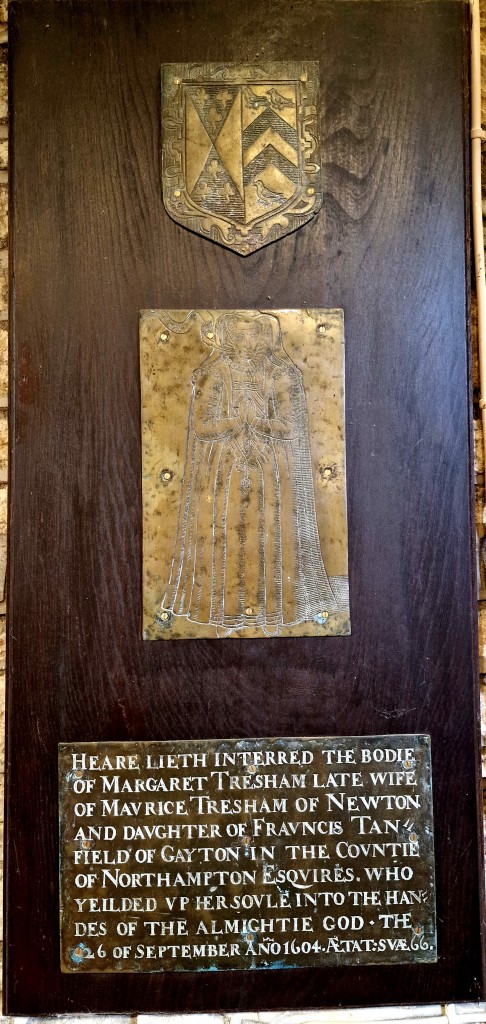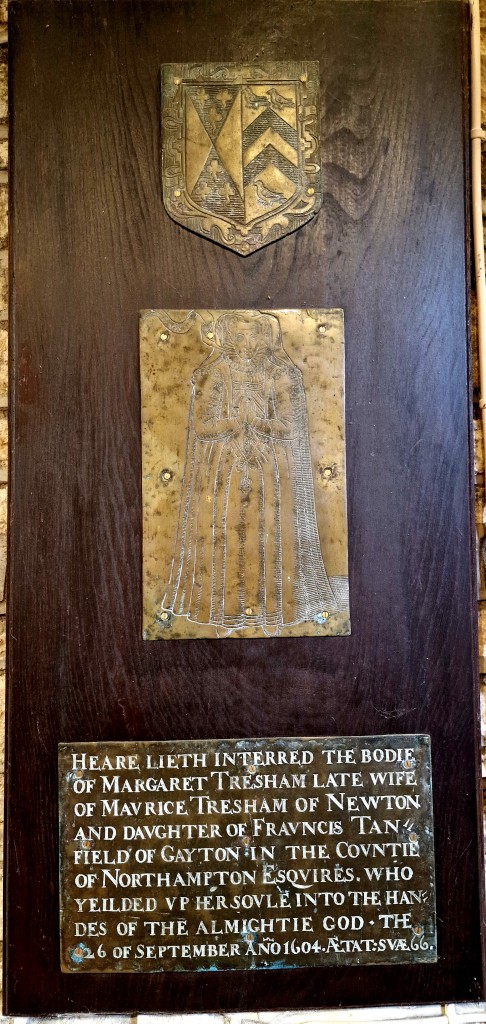Margaret Tresham
- Date of Brass:
- 1604
- Place:
- Geddington
- County:
- Northamptonshire
- Country:
- Number:
- II (Newton-by-Geddington)
- Style:
- Cure
Description
October 2025
The church of St Faith in Newton by Geddington (or Newton-in-the-Willows) was disused and derelict in the early 1970s. It is now a private house. All its church furniture and fittings have long since been removed. The brasses and incised slab listed in it were transferred to Geddington in or before 1974, with one exception. The inscription to Dorothy Tresham, d.1653 (M.S.III in Mill Stephenson's List of Monumental Brasses in the British Isles, 1926) is believed to have been stolen while the church was derelict and never recovered.
One of the brasses from Newton, that commemorating John Mulsho and his wife Joan, 1400, is well known and has been illustrated widely. Unlike the Mulsho brass and the incised slab, both positioned in the floor of the north aisle, the brass of Margaret Tresham is on the north wall of the ringing chamber in the tower, mounted on a wooden board. Mill Stephenson described her brass as comprising an effigy on a rectangular plate and an inscription. A third component, a shield displaying the arms of Tresham impaling Tanfield within a strapwork border, was discovered during the clearance of Newton church.
Margaret was the daughter of Francis and Bridget Tanfield of Gayton, Northamptonshire, and was born c.1538. She is depicted among their daughters on their incised slab at Gayton, a work of Richard Royley of Burton upon Trent, where her diminutive effigy is shown below her parents’ feet with the letter M engraved beneath. She appears to have been the fourth of ten daughters, four of her sisters dying as infants. She married Maurice Tresham esquire of Newton, about eight years her senior. According to the heraldic visitation she was his second wife. He is believed to have built the enormous dovecote at Newton that bears his name.
Margaret’s brass was designed by the Cure workshop in Southwark, but not necessarily engraved in-house. While almost all female figures in this style are in semi-profile, Margaret’s figure faces forward, like the figures of Elizabeth and Mary, wives of Michael Hare, died 1611, at Bruisyard in Suffolk. However, while those at Bruisyard are cut-out figures, Margaret’s is on a rectangular plate. The three figures are differentiated by the detail of the upper parts of their costume, although Margaret also has an open sleeveless gown that falls to her feet and a pomander hanging from her girdle.
Margaret's figure has a mouth scroll but nothing beneath her feet. In these two details, she is like the figure of Jane Bell, d.1591, also on a rectangular plate, at Hartlepool, Durham. Jane however is drawn in semi-profile.
Rectangular brasses in the Cure style normally have two or more figures, often family groups. Compared with Jane's plate at Hartlepool, Margaret’s has considerably more blank space.
The shield above Margaret's figure has a border of strapwork with a backgraound of vertical engraved lines, while some of the tinctures of the heraldry have horizontal broken lines. Whether this is to differentiate between different tinctures or is intended to represent particular tinctures is unclear. Some Cure-style brasses do aim to do this, in the manner of Zangrius’s forerunner of Petra Sancta’s system.
Copyright, photo and text: Jon Bayliss
- © Monumental Brass Society (MBS) 2025
- Registered Charity No. 214336


